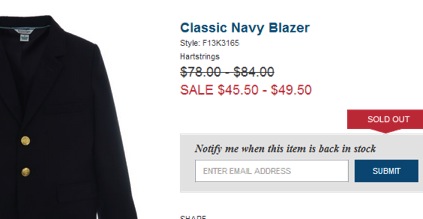SEO for Inventory and Seasonal Changes
 Ecommerce sites tend to have a fair amount of volatility in their inventory. Items are added, items removed. Items go out of stock temporarily and items are discontinued. How do you maintain the SEO value for items that come and go like that? For that matter, how do you ever develop SEO value for them?
Ecommerce sites tend to have a fair amount of volatility in their inventory. Items are added, items removed. Items go out of stock temporarily and items are discontinued. How do you maintain the SEO value for items that come and go like that? For that matter, how do you ever develop SEO value for them?
Why is Stock Volatility a Problem for SEO?
In theory at least, URLs should never go away. If you have successfully created a site with compelling content, you want — and expect — users to bookmark it, share it, tweet it, and link to it. Why in the world would you then want to remove it? You just don’t know where your links may be living and thriving quietly in the dark, until someone clicks one. And when they arrive at your (hopefully, beautifully crafted) 404 page, they are likely to lose some confidence.
If you have many 404 incidents, and therefore a high bounce rate, this too will negatively impact your trustworthiness, create a bad user experience, and lower the likelihood of your site ranking high for a related search. Google wants its search results to promise a good experience overall.
And most obviously, if a page is removed after a short lifespan, it can’t possible develop any real SEO value. It won’t accrue links, and it may not remain in Google’s index.
How to Handle Out-of-Stock Items in an Ecommerce Site
When a product is removed from inventory, you have a few options.
1) Keep the page live. Remove the “Buy Now” or “Add-to-Cart” button. If the item is temporarily unavailable, make that clear and offer a signup to be notified when it is available again.
2) If the item is permanently discontinued, you can remove it from the main navigation but leave it live, and on that page, offer recommendations for similar or replacement items.
3) Or you can permanently redirect it (with a 301 redirect) to a specific replacement item.
4) In the worst case, you may redirect it to the category page, though this could lead to confusion if there is no explanation as to why the user is landing there instead.
How to Handle Seasonality in Ecommerce
Sometimes, especially in fashion-related industries, items will disappear when the season ends, and be replaced with new items for the new season. These old items may come back later, in some generic form — like “Snow Boots” for example, or “Snow Blowers.” In the fashion apparel industry, they may simply never be seen again. In the gifting world, items appear in advance of a holiday or calendar event, and are then removed again as the calendar moves on. Think Valentine’s Day, Halloween costumes, Christmas, and Thanksgivukkah (which won’t be back for 70,000 years or so).
This is another kind of volatility that challenges your SEO efforts and makes it harder to build lasting value for those URLs.
In a case like this, there are a few important strategies to consider.
1) Keep your URLs generic and not date-specific. For example, use “valentines-day” but not “valentines-day-2014 “in the URL!
2) When the holiday is past, move the page out of the primary navigation but leave a link to it somewhere, so it can still be crawled, maybe from a “past collections” page. Once again, remove the “Buy Now” buttons, and offer a way to be notified of next year’s advance sales. When the next season approaches, begin blogging and linking to this section again, as you refresh its content and inventory. This Todd Snyder site uses generic URLs and navigation labels for all its main sections, and assigns a permanent URL to its collections gallery each year, and keeps them.
For Long-Lasting SEO – Don’t Rank and Yank
Think permanence and usability for maximum SEO impact. Provide the best user experience you can. Don’t play hide-and-seek with your products nor your URLs. Don’t invest SEO effort to rank, just to yank the content again later. Determine how best to leverage the content permanently, once you’ve created it and you’ll see your pages grow in value, despite the change of seasons.
Let us know how you manage seasonality and stock volatility and what has worked for you. And as always, give us a shout if we can help.














